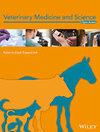乡村土鸡的家庭鸡群规模和年龄性别结构
IF 1.8
3区 农林科学
Q2 VETERINARY SCIENCES
引用次数: 0
摘要
背景原住民乡村鸡(IVCs)为农村发展做出了重要贡献。结果抽样家庭的平均鸡群规模较小(平均 = 7.28,范围:1-38)。雌禽(母鸡和小鸡)在家庭鸡群中所占比例最大(50.2%)。雏鸡(26.4%)和小鸡(14.4%)的比例低于母鸡(35.8%)的比例,这给生产替代种鸡群带来了相当大的挑战。同样,公鸡的比例(9.1%)也低于公鸡(14.3%)。公鸡与母鸡的平均比例(1 只公鸡对 7 只母鸡)优于通常推荐的比例(1 只公鸡对 8-10 只母鸡)。因此,小农没有面临生产不孕蛋的问题。估计的有效种群数量(Ne)为 4.02,相应的近亲繁殖系数为 0.12,这表明在一定程度上近亲繁殖可能会在家庭鸡群中发生;此外,估计的有效种群数量占普查规模的 55.2%。然而,近亲繁殖可能会被族群的高更替率和食腐鸟类之间不受控制的交配所抵消。然而,由于鸟类之间无节制的繁殖,近亲交配的比例大大降低。雏鸡和幼鸟比例低以及家庭鸡群规模大的驱动因素需要进一步研究,以提高当地鸡对农村生计的贡献。本文章由计算机程序翻译,如有差异,请以英文原文为准。
Family flock size and age–sex structure of indigenous village chickens
BackgroundIndigenous village chickens (IVCs) significantly contribute to rural development. There is considerable variation in family flock size and age–sex structure of IVCs.ObjectivesThis study reports the family flock size, age–sex group structure, and demographic history of IVCs.MethodsThis work involved a cross‐sectional study conducted using face‐to‐face general informants’ individual interviews with 119 smallholder farmers in highland and lowland agroecological zones.ResultsThe average family flock size of the sampled households was small (mean = 7.28, range: 1–38). Female birds (hens and pullets) represented the largest proportion of the family flocks (50.2%). The proportion of chicks (26.4%) and pullets (14.4%) was lower than that of hens (35.8%), which creates a considerable challenge in producing replacement breeding flocks. Similarly, the proportion of cockerels (9.1%) was lower than that of cocks (14.3%). The average cock‐to‐hen ratio (one cock to seven hens) was better than the commonly recommended proportion (1 cock to 8–10 hens). As a result, smallholder farmers have not faced the problem of producing infertile eggs. The estimated effective population size (Ne) of 4.02 and the corresponding inbreeding coefficient of 0.12 at the family flock level show that to some extent inbreeding may occur at the family flock level; besides, the estimated Ne represents 55.2% of the census size. However, inbreeding could be offset by the high rate of flock turnover and uncontrolled mating among scavenging birds.ConclusionsFamily flocks contain a few birds, which may lead to consanguineous mating. Inbreeding is, however, considerably reduced by uncontrolled breeding among birds that share a common scavenging ground. The driving factors behind the low proportion of chicks and juvenile birds and the family flock size need to be further investigated to improve the contribution of local chickens to rural livelihoods.
求助全文
通过发布文献求助,成功后即可免费获取论文全文。
去求助
来源期刊

Veterinary Medicine and Science
Veterinary-General Veterinary
CiteScore
3.00
自引率
0.00%
发文量
296
期刊介绍:
Veterinary Medicine and Science is the peer-reviewed journal for rapid dissemination of research in all areas of veterinary medicine and science. The journal aims to serve the research community by providing a vehicle for authors wishing to publish interesting and high quality work in both fundamental and clinical veterinary medicine and science.
Veterinary Medicine and Science publishes original research articles, systematic reviews, meta-analyses, and research methods papers, along with invited editorials and commentaries. Original research papers must report well-conducted research with conclusions supported by the data presented in the paper.
We aim to be a truly global forum for high-quality research in veterinary medicine and science, and believe that the best research should be published and made widely accessible as quickly as possible. Veterinary Medicine and Science publishes papers submitted directly to the journal and those referred from a select group of prestigious journals published by Wiley-Blackwell.
Veterinary Medicine and Science is a Wiley Open Access journal, one of a new series of peer-reviewed titles publishing quality research with speed and efficiency. For further information visit the Wiley Open Access website.
 求助内容:
求助内容: 应助结果提醒方式:
应助结果提醒方式:


